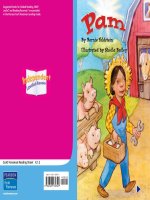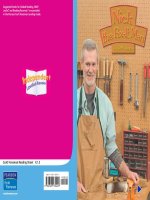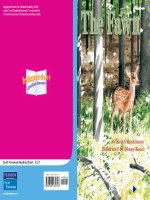- Trang chủ >>
- Mầm non - Tiểu học >>
- Lớp 5
5 6 5 jazz, jazz, jazz (Scott Foresman)
Bạn đang xem bản rút gọn của tài liệu. Xem và tải ngay bản đầy đủ của tài liệu tại đây (4.75 MB, 14 trang )
Suggested levels for Guided Reading, DRA,™
Lexile,® and Reading Recovery™ are provided
in the Pearson Scott Foresman Leveling Guide.
Jazz, Jazz,
Jazz
by Sharon Franklin
Genre
Narrative
nonfiction
Comprehension
Skills and Strategy
• Sequence
• Fact and Opinion
• Prior Knowledge
Text Features
• Captions
• Glossary
• Time Line
Scott Foresman Reading Street 5.6.5
ISBN 0-328-13589-5
ì<(sk$m)=bdfij < +^-Ä-U-Ä-U
Vocabulary
bass
clarinet
fidgety
forgetful
jammed
Reader Response
Jazz, Jazz,
1. Louis Armstrong moved several times before settling
in New York. Use a chart like the one below to list in
order the dates and events mentioned in the book
that end with his making New York his home base.
Jazz
by Sharon Franklin
nighttime
secondhand
Word count: 1,696
2. What are some things you know about American
history that help you understand the importance of
the rise of African American music?
3. How does the context for of the word jammed on
page 8 help you know the meaning of the word?
4. What are some other events from the book that could
be added to the time line on pages 22 and 23?
Note: The total word count includes words in the running text and headings only.
Numerals and words in chapter titles, captions, labels, diagrams, charts, graphs,
sidebars, and extra features are not included.
Editorial Offices: Glenview, Illinois • Parsippany, New Jersey • New York, New York
Sales Offices: Needham, Massachusetts • Duluth, Georgia • Glenview, Illinois
Coppell, Texas • Ontario, California • Mesa, Arizona
The Harlem Renaissance
From 1917 to 1935, Harlem was an important
cultural center of the United States. Certain events
and people came together in a way that only happens
once in a great while. These events led to an explosion
of African American art, literature, and music.
Historians call this period the Harlem Renaissance.
A renaissance is a rebirth, and after World War I,
everyone was eager to have life start again.
Who was involved in the music scene in Harlem?
How did these composers, singers, and musicians
contribute to the development of jazz? What was
Harlem like?
Every effort has been made to secure permission and provide appropriate credit for
photographic material. The publisher deeply regrets any omission and pledges to
correct errors called to its attention in subsequent editions.
The neighborhood of Harlem in 1937
Unless otherwise acknowledged, all photographs are the property of Scott Foresman,
a division of Pearson Education.
Photo locators denoted as follows: Top (T), Center (C), Bottom (B), Left (L), Right (R),
Background (Bkgd)
Cover(TL) ©Bettmann/CORBIS; Cover(TR) ©Bettmann/CORBIS; Cover(BR) ©Metronome/
Getty Images; Cover(BL) ©Bettmann/CORBIS; 1(T) ©Profiles in History/CORBIS; 1(B)
©Frank Driggs Collection/Getty Images; 3 ©Bettmann/CORBIS; 4 ©Photo Collection
Alexander Alland, Sr./CORBIS; 5 ©Bettmann/CORBIS; 6(C) ©Bettmann/CORBIS; 6(B)
©Bettmann/CORBIS; 7 ©CORBIS; 8 ©Frank Driggs Collection/Getty Images; 9 ©Profiles
in History/CORBIS; 10 ©Terry Cryer/CORBIS; 11 ©Eliot Elisofon//Time Life Pictures/Getty
Images; 12(C) ©Bettmann/CORBIS; 12(B) ©Underwood & Underwood/CORBIS; 13
©Frank Driggs Collection/Getty Images; 14 ©Bettmann/CORBIS; 15(C) ©Metronome/
Getty Images; 15(Bkgd) ©Bettmann/CORBIS; 16 ©Bettmann/CORBIS; 17 ©Bettmann/
CORBIS; 18 ©Bettmann/CORBIS; 20 ©Frank Driggs Collection/Getty Images; 21
©Genevieve Naylor/CORBIS; 23 ©CORBIS
ISBN: 0-328-13589-5
Copyright © Pearson Education, Inc.
All Rights Reserved. Printed in China. This publication is protected by Copyright,
and permission should be obtained from the publisher prior to any prohibited
reproduction, storage in a retrieval system, or transmission in any form by any
means, electronic, mechanical, photocopying, recording, or likewise. For information
regarding permission(s), write to: Permissions Department, Scott Foresman, 1900 East
Lake Avenue, Glenview, Illinois 60025.
4 5 6 7 8 9 10 V0H3 14 13 12 11 10 09 08 07 06
3
In the nighttime this neighborhood is even more
lively! You might think people would be sleeping at
3 A.M., but not in Harlem. This joint is jumping with
the sounds of jazz all night long.
Theaters, cafes, and dance halls offer shows
around the clock. People come from all over to be
entertained. Some of the jazz musicians performing
here will become famous around the world.
Harlem was bursting with activity in the 1920s.
Harlem
Imagine that it is a hot, steamy summer day in
New York in 1924. You are walking down 125th
Street. Elderly people sit on their front steps fanning
themselves and calling to neighbors. Children jump
rope and play ball in the street. Fidgety teens tune
their radios to the latest music. Everywhere, melodies
float out to the street through open windows. A
few forgetful singers hum along with their favorite
songs, even if they can’t remember all the words.
As you walk down the street you can hear
someone practicing his secondhand bass. When you
round the corner you find a couple practicing dance
steps. This is Harlem in the daytime.
4
5
Now you have a feeling for what it was like to be
in Harlem in the 1920s and 1930s. Let’s meet three
musicians who helped create all this excitement.
Louis Armstrong, Fletcher Henderson, and Duke
Ellington were young men when they came to
Harlem. But these three, along with other African
American musicians, would change the music scene
forever.
They each came from different places but moved
to Harlem within four years of each other. What was
going on with jazz when these three first got into
music? How did they influence the development of
jazz?
The Birth of Jazz
The story of jazz in Harlem actually begins in the
South. We say that jazz was “born” in New Orleans,
Louisiana, in the late 1890s and early 1900s. But
really, jazz was created over time. Different styles of
music came together in unexpected ways.
Local musicians in New Orleans experimented
with two types of music called blues and ragtime.
They mixed the styles and tried new instruments.
They also introduced the idea of improvising, making
things up as they went along. This mix of sounds was
the beginning of the style of music we call jazz.
Louis Armstrong (above) and Duke
Ellington (left) were two of the musical
powerhouses who transformed
jazz from an experiment to
an art form.
New Orleans in the first part of the 20th century
6
7
Many of the musicians in New Orleans were
Creoles. Creoles, who were descended from African
Americans and Louisiana’s French and Spanish
settlers, shared a blended heritage. They knew about
different kinds of music.
New Orleans was also a major port, which meant
that people from all over the world could come to
this city. It was a place where the mixing of cultures
was very much accepted. It makes sense that a new
type of music could emerge in a place with open and
adventurous people.
Louis Armstrong
Louis Armstrong grew up in New Orleans. When
he was seven years old, he bought his first trumpet.
As a teenager, he jammed with local pick-up bands
who were mixing ragtime and blues music.
Recordings Armstrong made with his band, the Hot Five, are
considered some of the best in jazz history.
8
Louis Armstrong, “The King of Jazz”
9
Scat
Louis Armstrong was both a talented horn player
and an inspired singer. He invented a way of singing
called “scat.” Scat is a way of singing that makes
your voice sound like an instrument.
There is a legend that Armstrong invented scat
by accident one night while he was performing.
They say he dropped his sheet music and started
singing nonsense words and sounds, and the
audience loved it.
Louis Armstrong is considered one of the greatest jazz
musicians of all time.
In 1922 Armstrong left New Orleans for
Chicago. There, he joined King Oliver’s Creole
Jazz Band. The band was popular, but it was
Louis Armstrong who was the real star.
Armstrong was known for the joy and
energy he brought to his trumpet playing
and singing. He had a unique sound that he was
constantly improving and modifying. He was a
master at improvisation. This made his work exciting
and lively.
In 1924 Armstrong was invited to join Fletcher
Henderson’s big band based in New York City.
He moved to Harlem. Armstrong stayed with
Henderson’s band for only one year. But he would
return to New York again in 1926 and make it his
home base for the rest of his life.
10
11
Scat was new, exciting, and a huge contribution
to jazz. This style of performing was picked up by
other major singers, such as Ella Fitzgerald.
Louis Armstrong led bands of his own and toured
the country in the 1930s. He became a true celebrity.
Armstrong’s innovations helped make jazz an
established and accepted art form.
Fletcher Henderson (right) and part of his orchestra
Fletcher Henderson
Louis Armstrong and his
band (above)
Ella Fitzgerald (right) was
inspired by Armstrong’s
singing style.
12
When Fletcher Henderson invited Louis Armstrong
to join his band in 1924, Henderson had been in New
York for only a few years.
Henderson was born in Georgia and had a degree
in chemistry from Atlanta University. In 1920 he came
to New York to continue his studies, but he found
that chemistry jobs were hard to get because he was
African American.
13
Henderson had played the piano since he was a
child, and he soon found work as a pianist. Later, he
started a band of his own.
The Big Band Sound
Fletcher Henderson is credited with creating the
first jazz big band. At first, his band was a traditional
dance band. Then, slowly, he hired more adventurous
musicians, such as Louis Armstrong. Together they
introduced more African rhythms and jazz sounds.
Henderson had a gift for discovering new talent.
Many of the musicians he brought into his band
became famous, and in time, almost every important
jazz player worked with Henderson. This made
Henderson’s group the most successful African
American band of the 1920s.
Henderson also arranged music, both for his
band and for others, including many white bands.
In 1939 Henderson was hired by Benny Goodman.
This was the first time a white band hired an African
American musician to appear on stage with them.
Many white bands played African American jazz.
Fletcher Henderson was a bandleader and a music arranger.
14
15
Throughout the 1920s, the biggest and most
famous clubs in Harlem introduced white audiences
to African American music, though whites and blacks
remained separated. But when the Savoy ballroom
opened in 1926, it was integrated. The club hired
both African American and white musicians, and it
allowed both African American and white customers.
Fletcher Henderson’s band was the first act to open
at the Savoy.
The Savoy was also unique because of its size. It
could hold more than four thousand guests. One
thing that drew crowds to the Savoy was the club’s
battle of the bands. Two bands would play, one at
either end of the hall, and the dancers would judge
which one was best.
Other famous clubs included the Apollo and
The Cotton Club. The Cotton Club was where Duke
Ellington got his big break.
The Savoy was one of Harlem’s best known nightclubs.
16
17
Duke Ellington
Duke Ellington grew up in
Washington, DC. He played the
piano as a teenager. He moved
to New York City in 1923 and
started a band called the
Washingtonians. In 1927
Ellington and his orchestra
were hired to perform at
The Cotton Club.
The Cotton Club gave Ellington’s orchestra
both local and national visibility. The club was very
popular, and the rich and the famous, from movie
stars to gangsters, packed the place nightly. Also,
NBC broadcast the Ellington Orchestra performances
over the radio.
Ellington was famous for his unusual sound. He
loved to experiment and wrote all kinds of exotic
jungle sounds to be played on piano, drums, and
even clarinet. He also wrote more than 180 pieces of
music in the four years he was at The Cotton Club.
Like Louis Armstrong, Ellington is considered a jazz
great.
Duke Ellington loved to play ragtime piano.
18
19
Three factors helped set the stage for the Harlem
Renaissance. None of them seemed to have anything
to do with music. They were improved education for
African Americans, the reaction to World War I,
and poverty in the southern states.
Improved Education
The Cotton Club
Summary
Louis Armstrong, Fletcher Henderson, and
Duke Ellington were three talented musicians who
each helped make jazz an established art form.
Armstrong’s scat singing, Henderson’s jazz big band,
and Ellington’s unique sound are innovations that
influence today’s musicians.
In 1863 President Lincoln declared the slaves
in the South free. Forty years later, some African
Americans were still poor, but they were free. They
were allowed to attend public schools.
Young people who can read and write have more
ways to express their creativity. They are also better
prepared to be in business
for themselves. Better
education had positive
effects on young
African Americans
who wanted to
make a living as
musicians.
Afterword: Why the Harlem
Renaissance?
Now you know about a few of the musicians who
were part of the Harlem Renaissance. But why did
so many talented people end up in the same place
at the same time? Why did they all have so much
energy for creating new kinds of music and other
art?
20
21
The Reaction to World War I
The Great Migration
After the end of World War I in 1918, Americans
were eager to create something new and positive.
This was their reaction to the destructiveness of war.
This set the stage for great economic growth, as well
as for lots of creative work in writing, art, and music.
During the early 1900s, more than a million
African Americans moved from the South to the
North in search of jobs. They left places like New
Orleans and ended up in cities like Chicago, Los
Angeles, and New York. This movement came to be
called the Great Migration. It turned out that a lot
of very talented people moved to Harlem all at the
same time.
Conclusion
These three things together—improved
education, reaction to WWI, and the Great
Migration—put the players in motion, so they could
create the Harlem Renaissance.
New York City in the 1930s
African Americans in the U.S.:
From
from Slavery to The Harlem Rennaissance
1914–1918:
1914-1918:
World War I
1917–1935:
1917-1935:
The Harlem Renaissance
1863:
1863:
President Lincoln
declares the slaves
in the South free.
1900–1930
1900-1930::
The Great Migration
1860
1900
22
1910
1920
1930
1940
23
Glossary
Vocabulary
bass
bass
n. a stringed
instrument that plays the
lowest
tones.
clarinet
clarinet n. a long, thin
woodwind
fidgetyinstrument
with a reed mouthpiece,
played
by means of holes
forgetful
and keys.
fidgety
adj. restless
jammed
forgetful adj. likely to
forget;
having a poor
nighttime
memory.
Reader Response
jammed v. took part in
a gathering of musicians
where music was played
and improvised.
1. Louis Armstrong moved several times before settling
in New York. Use a chart like the one below to list in
order the dates and events mentioned in the book
that end with his making New York his home base.
nighttime n. time
between evening and
morning.
secondhand adj. not
purchased new; already
used by someone else.
secondhand
Word count: 1,696
2. What are some things you know about American
history that help you understand the importance of
the rise of African American music?
3. How does the context for of the word jammed on
page 8 help you know the meaning of the word?
4. What are some other events from the book that could
be added to the time line on pages 22 and 23?
Note: The total word count includes words in the running text and headings only.
Numerals and words in chapter titles, captions, labels, diagrams, charts, graphs,
sidebars, and extra features are not included.
24









